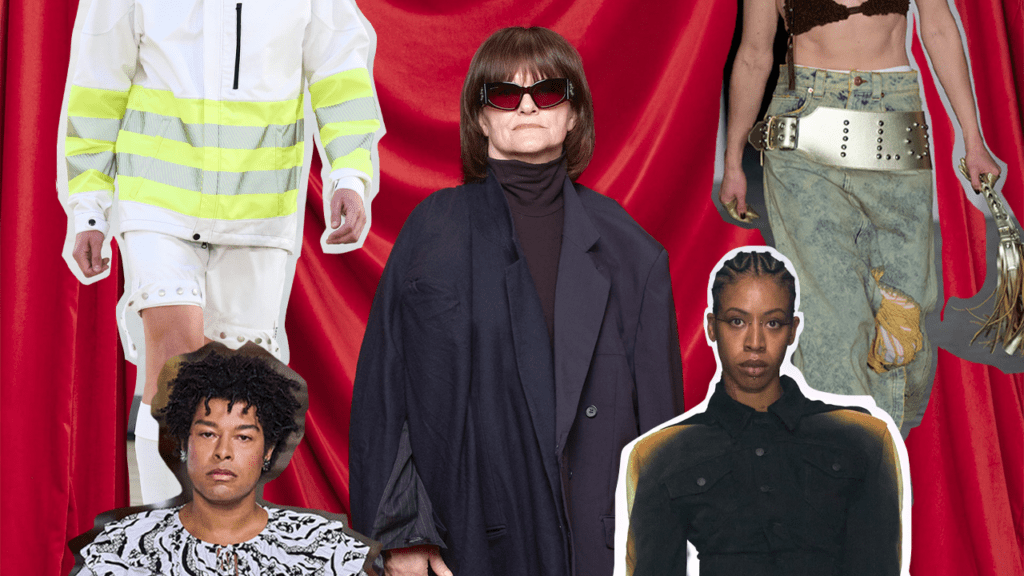At a late-evening show on the penultimate day of London Fashion Week, a staff writer at a competitor magazine turned around to me and said: “When am I going to be cast in something? What’s wrong with me?” Fitting, because he spent a large proportion of our conversation listing all of the times he had been included in street-style galleries recently. But this wasn’t a question of an outsized fashion ego. The past couple of seasons have seen a steady increase in the number of industry insiders taking turns on the catwalk. That an aspirant cool-kid journalist should be waiting in the wings for his big “debut” is now entirely plausible. There’s real kudos in being positioned as that kind of cultish figure on the scene.
This interaction took place weeks before fashion critic Cathy Horyn joined the cast of Demna’s spring/summer 2024 show at Balenciaga, alongside blogger Diane Pernet and publicist Robin Meason. The fashion designer Mowalola Ogunlesi then made a cameo in Mugler’s makeshift wind tunnel, following Sinéad O’Dwyer’s appearance at Chopova Lowena during London Fashion Week, while i-D writer Joe Bobowicz walked for Olly Shinder’s debut at Fashion East. His editor, Mahoro Seward, was cast on Chopova Lowena’s spring/summer 2023 catwalk, the same season that Acne Studios’s CMO and former Dazed editor-in-chief Isabella Burley was trundled out at Vaquera.
In casting members of their own professional (and social) circles, it would seem these designers have realised the value of running a fashion person’s fashion brand. “I think we all love an ‘if you know, you know’ moment,” says casting director Sarah Small of Good Catch, who works with Chopova Lowena. “And runways are perfect for this because you have the opportunity to bring a group of people together with shared attitudes. So it makes sense not to base casting decisions on aesthetics alone.” Small’s work (along with Emma Matell and Troy Fearn’s) has given rise to a new genre of model, one that puts an emphasis on street-cast faces: real, eccentric and often unpolished, revealing a sense of humanity beneath the clothes.
“Street casting has paved the way for less expected beauties to make an appearance on the runway,” she says. “It’s connected to, but different from, casting insider talent, which is more closely linked to what those people represent.” A co-sign from a well-respected name is perhaps worth more to a designer than hiring a professional billboard for a couple of minutes. It’s why Jo Ellison walked for Dolce & Gabbana in 2017 and Matthew Schneier walked for Vaquera in 2018. These relationships go deeper than those of a traditional model-designer set-up. It’s a dialogue. The same goes for Alexander McQueen, who modelled for Rei Kawakubo in ’97, and Martin Margiela for Jean Paul Gaultier in ’98.
And yet this all felt markedly different from those ’90s cameos. Since lockdown ended, celebrity, spectacle and the collision of the two have been central to fashion month’s rebooted IRL offering. The image of Dua Lipa licking her lips on the spring/summer 2022 Versace catwalk haunts me like a World War II flashback. See also: Balenciaga’s bomb craters and Bella Hadid clasping her breasts as a latex dress is sprayed onto her in real-time. The clothes have been just as attention-seeking. This shift has been met with scepticism from critics, who consider these antics concept-thin, attention-grabbing stunts. Case in point: the publicity-starved Tommy Ca$h aping as a homeless person at Y/Project.
But this season, it felt as though the industry was turning its gaze back on itself: presenting post-meme wardrobes on pre-Instagram models like Agyness Deyn and Malgosia Bela. There were some VIP cameos (among them Troye Sivan and Cailee Spaeny at Miu Miu, Angela Bassett and Paris Hilton at Mugler, and Mia Khalifa at KNWLS) but there were fewer headline-generating appearances. In general, the appetite for A-listers wasn’t quite there. “There will never be a time without models and celebrities, but once anything becomes conventional, it no longer creates the stimulus necessary for someone to pay attention,” says W David Marx, the author of Status and Culture. “And so you have to keep subverting those conventions.”
“The idea of using very attractive, model-like people has felt quite stale for a long time,” he continues. “So to use a different kind of person is a good marketing trick. Relevance is such a scarce currency at the moment, and there’s so few ways to drum up the right kind of attention.” Was Balenciaga’s SS24 casting an attempt at pandering to the fashion establishment? Even if the collection had lacked in substance (which it didn’t), the presence of Horyn would have bathed Demna in a halo of intellect. “It works both ways,” Marx adds. “The insider gets a level of fame they might not have had before, and the brand acquires relevance. Remember, not all insiders want to be hidden behind the scenes anymore.”
If someone wants to create a name for themselves, there is now an expectation to be an active participant in the fashion circus. Brands will continue to rely on celebrities to disseminate their message to as wide an audience as possible, but it’s perhaps a much nobler task to win the approval of the in-crowd. To cast an esteemed journalist over a famous supermodel is an explicit endorsement of the virtues they’re seen to uphold: knowledge and integrity and hard-won connoisseurship. It’s a small gesture, with enormous subtext for those who happen to be in the know. And if you don’t know? Well, you might look at the clothes these people are wearing instead.





.png)

